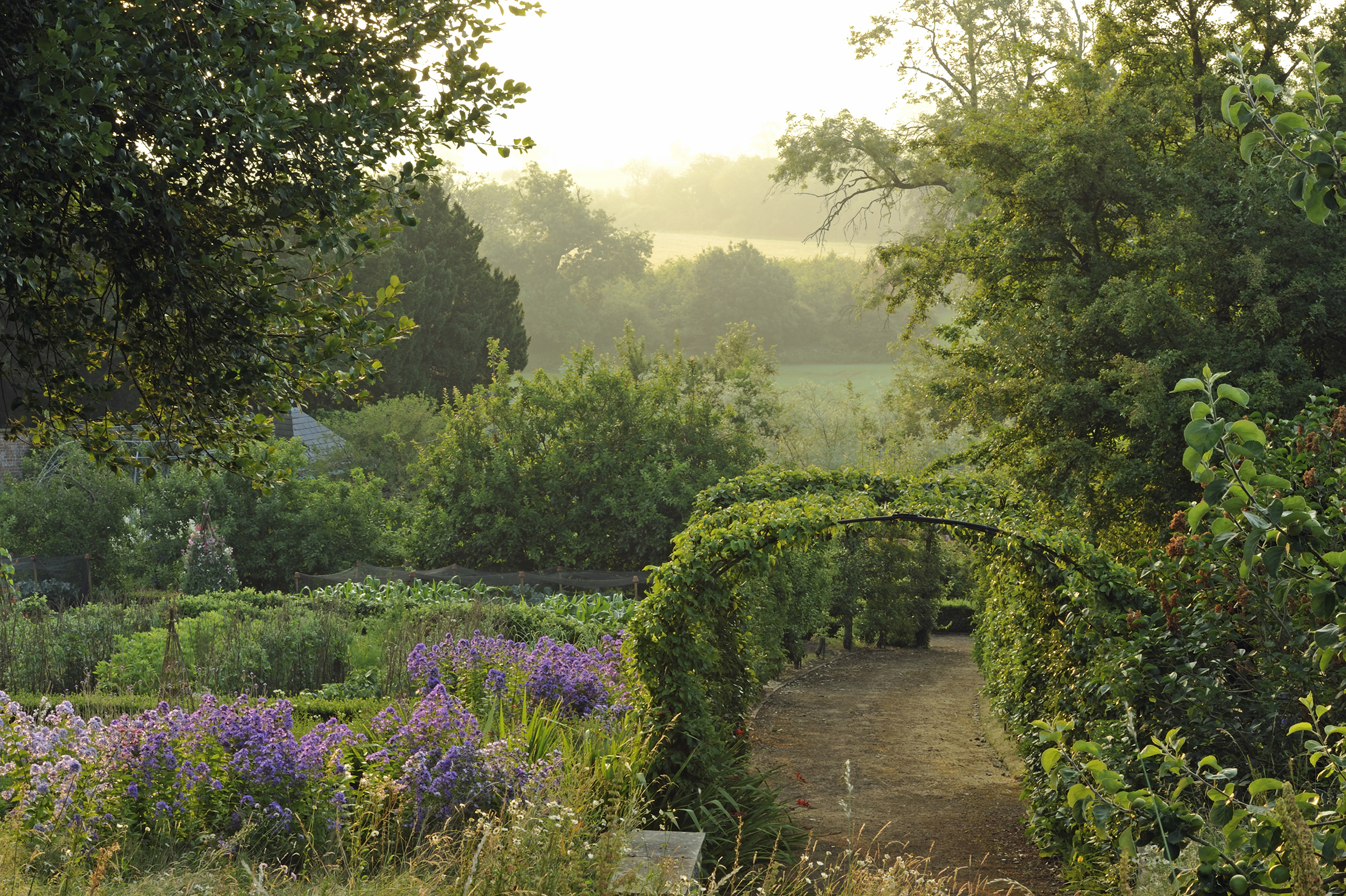A rare treasure of a garden that brings joy at every level, hidden away in the Welsh valleys
Hidden in the Welsh valleys is The Pant, a garden of myriad sources that leaves others in the shade, says James Alexander-Sinclair. Photographs by Britt Willoughby Dyer.


The primary purpose of a garden is, I believe, to bring joy. Hearty exercise, peace, satisfaction and stimulus are a given, but the magic ingredient is unalloyed joy. This should be freely given, most importantly, to the creators, secondly, to visitors and, thirdly, to the plants and creatures fortunate enough to call it home.
The gardens at The Pant give joy on every level: I’ve visited twice and am already scouring my diary for a third foray and telling anybody who will listen that this is an extremely special place. These 25 acres of glorious woodland and valley (a pant, as I’m sure you were already aware, is a valley without surface water – it’s the opposite of a nant) near Abergavenny surround the home of Jeremy and Camilla Swift.

Jeremy bought The Pant in 1992 in spite of first impressions. ‘There was a dilapidated stone shed filled with builders’ rubble and a dead sheep,’ he remembers, but he’s not a man who is easily disheartened, having spent much of his life in wild places. ‘I worked in Africa a great deal, getting involved with wildlife and conservation’, so some steep woodland in Wales was child’s play.
Since then, the sheep mortuary has become a fine house surrounded by a garden that weaves together strains of beauty, history, humour and pure fantasy. There is a quote from Horace (it’s that kind of garden), chiselled into a stone by the house, which sums it up quite neatly: ‘This is what I prayed for. A piece of land, not so very big, with a garden and, near the house, a spring that never fails, and a piece of woodland to round it off.’
'Broadly, it’s about the contrast between the wild and the formal.'
It’s not a space that fits conveniently into any of our predetermined design boxes, but, broadly, it’s about the contrast between the wild and the formal. It accomplishes this through a series of gardens, beginning by the house, where the ground has been shaped into a series of stone terraces.
First up is the black border, which has softened over the years to include Astrantias, Thalictrum and deep-red dahlias. Near here is the formal knot garden (inspired by the Ruspoli garden at Vignanello), which surrounds Camilla’s office – there’s a double box hedge that’s a true work of art.

On the next step up is a neatly enclosed canal that bears the obvious hallmarks of Moghul and Islamic influence. This is affectionately known as the Osama bin Garden, a very calming place and a surprising thing to find on a Welsh hillside.
Sign up for the Country Life Newsletter
Exquisite houses, the beauty of Nature, and how to get the most from your life, straight to your inbox.
From here, we start climbing, past a steep bank that’s flecked with wildflowers, species tulips and snake’s-head fritillaries. For a good overview down over the house and orchards, there is a magnificent tree house built around a cluster of trunks. Jeremy clarifies: ‘The children and grandchildren won a national design competition: it’s shaped like an ark to remember the serious rains of 2001.’
'You can see across the valley and towards a large pond that, for no particular reason, has been dug in the shape of a whale'
This theme of memory runs throughout the place – on every step are carved the names of the family’s favourite gardens around the world: we walk over Rousham (Oxfordshire), Bagh-e-fin (Iran), Courances (France) and Bomarzo (Italy).
Out in the woods, we’re constantly surprised – there are unicorns, a mandril perched on a pedestal, the god Pan spilling water and, on rocks throughout the hillside, are carved the names of nomadic tribes. Jeremy, an eco-nomic anthropologist, is an expert on these groups, having spent much of his life living and travelling with the Tuareg, the Boran and the WoDaaBe among others, and it’s wonderful that these far-flung peoples are remembered here. ‘Some of the carvings are easy to find, but others are really well hidden – only I know where they are!’

A bit further and, suddenly, there’s an enormous picture frame suspended by invisible wires from the trees. This is a deliberate reversal of the Claude Mirror, a device with which well-travelled 18th-century gentry tried to imitate the style of Claude Lorrain by painting landscapes as viewed in a dark-tinted mirror. Jeremy sensibly points out that ‘it seemed simpler to us to hang up an empty frame and paint it directly’.
Through the frame, you can see across the valley and towards a large pond that, for no particular reason, has been dug in the shape of a whale – its spout is fed by gravity from a spring on the hill. ‘I stood on the hill and my brother stood by the pond with a walkie-talkie so we could get the shape right.’

As if this were not enough, we then come across a green theatre that was dug on a whim and is now the location for concerts, parties and, apparently, wild debauchery (when it’s not raining). It’s modelled on similar theatres found in Renaissance villas in Italy and is decorated with busts and statues (one of which looks exactly like Alastair Campbell).
Next is an enormous stone turtle (of course), which was built by a former SAS soldier- turned-dry-stone waller: ‘Turtles are essential,’ says Jeremy. ‘Many cultures believe the world sits on the back of a turtle.’ This one emerges from the trees and is occasionally used as a landmark by low-flying aircraft.
'This is a garden that gladdens the heart, floats your boat and brings joy to the soul of all those lucky enough to visit.'
At this point, one wonders what the next eccentricity might be and the garden throws up the last thing one might expect: a buried hamlet the family has uncovered over the past decade. There are at least three houses, built from the late 15th to 17th centuries, but why they are there is a bit of a mystery.
There is evidence that the houses were occupied by quite prosperous people (good-quality pottery has been found), which must mean that they had a purpose. They could have been used for charcoal burning or iron processing or, perhaps, the site was a refuge for recusant families in hiding. Nobody yet knows, but excavations continue.
Another garden appears, this one a chequerboard homage to the gardens at Lunuganga in Sri Lanka that were made by the architect Geoffrey Bawa. To transfer Sri Lanka to Wales requires a bit of imagination, so the frangipani trees are now Cornus kousa and the rice paddies have become squares of lush greenery. Shoehorning in another reference, there are also four developing magnolias that are a nod to the gardens of Anthony House in Cornwall.

Our penultimate stop before coming back to the house is the Camels at the Gate: a series of urns affixed to the top of tall poles with, beneath it, a caravan of topiary camels lying at rest, having invaded a palace.
Finally, and easy to miss, is the Screaming Party, in which a line from the Welsh poet R. S. Thomas indicates a flock of swifts flying low and fast through the trees.
All this has sprung from Jeremy’s very brilliant mind, aided in no small measure by Camilla, who’s a much-admired garden writer and a former trustee of the National Botanic Garden of Wales. Much of the work has been carried out by Jeremy’s own hands, although he’s now ably supported by Rhodri Willson, who arrived in a campervan in 2008 and now digs, prunes and cuts hedges with relentless enthusiasm. ‘It seemed appropriate that a Welsh nomad should arrive at The Pant after I had spent so much of my life with nomads across the world,’ notes Jeremy.

As I leave, he gives me what appears to be a guidebook written by one James Rymer. In it, numerous spoof historic and artistic connections to The Pant are recorded, such as its settlement by the Romans, the creation of a monastery (the Archbishop of Canterbury came to stay) and visits by such luminaries as Shakespeare – apparently, A Midsummer Nights’ Dream was first tried out at The Pant. Clearly, huge fun has been had referencing Wordsworth, Daniel Defoe and Milton, who supposedly wrote letters or poems about the place. Gilbert White and T. S. Eliot spent time here, not to mention the times that the great landscape architects Charles Bridge-man and William Kent allegedly visited.
As I said at the start, this is a garden that gladdens the heart, floats your boat and brings joy to the soul of all those lucky enough to visit.
The Pant, Fforest Coal Pit, Abergavenny, Monmouthshire. To visit, email camilla@camillaswift.co.uk

Credit: Getty Images/Caiaimage
Alan Titchmarsh: How I grow dahlias — and why they're my second-most infallible plants
Gardener, writer and broadcaster Alan Titchmarsh has always loved dahlias — even in the days before they gained their current huge

The worst garden pests of all? The ones you invite in with open arms
A couple of weeks ago, Alan Titchmarsh wrote a lovely piece for Country Life about how to get children and

How to create a tunnel of pears in your garden
Few things are as beautiful and yet bear such fruit — literally — as a tunnel of fruit trees in your

Credit: Getty
A peek behind the scenes at France's annual rose extravanganza at the Parc de Bagatelle
Charles Quest-Ritson, quite literally the man who wrote the book on roses, reveals what goes on at France's annual Concours

Credit: Alamy
Why quince, beloved by everyone from Edward I to the Ancient Greeks, is the perfect autumn fruit
Country Life is unlike any other magazine: the only glossy weekly on the newsstand and the only magazine that has been guest-edited by HRH The King not once, but twice. It is a celebration of modern rural life and all its diverse joys and pleasures — that was first published in Queen Victoria's Diamond Jubilee year. Our eclectic mixture of witty and informative content — from the most up-to-date property news and commentary and a coveted glimpse inside some of the UK's best houses and gardens, to gardening, the arts and interior design, written by experts in their field — still cannot be found in print or online, anywhere else.
-
 What should 1.5 million new homes look like?
What should 1.5 million new homes look like?The King's recent visit to Nansledan with the Prime Minister gives us a clue as to Labour's plans, but what are the benefits of traditional architecture? And can they solve a housing crisis?
By Lucy Denton
-
 Having a ruff day: Kennel Club exhibition highlights the plight of vulnerable spaniel breeds
Having a ruff day: Kennel Club exhibition highlights the plight of vulnerable spaniel breedsPhotographer Melody Fisher has been travelling the UK taking photographs of ‘vulnerable’ spaniel breeds.
By Annunciata Elwes